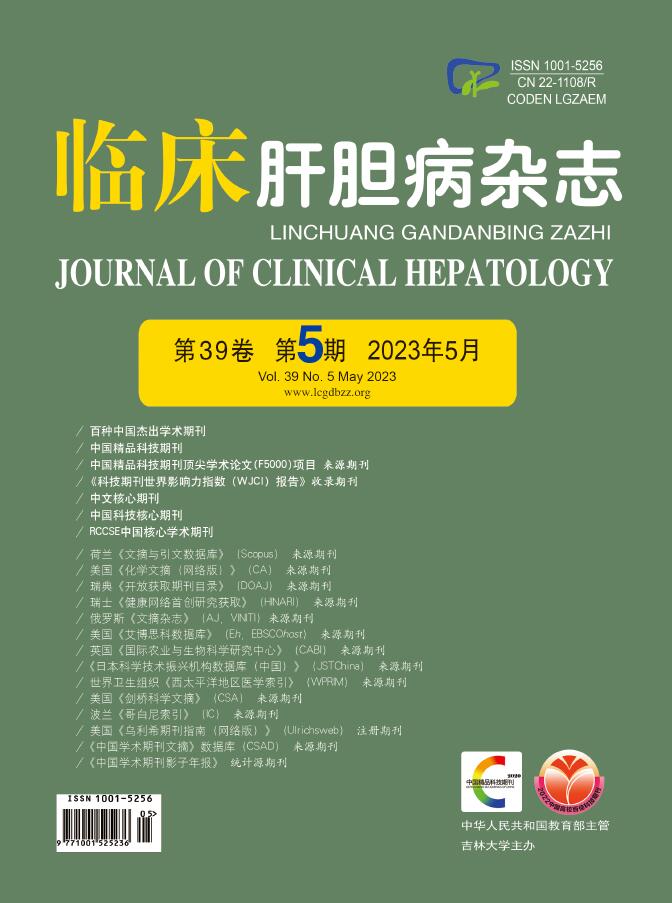| [1] |
BAJAJ JS, O'LEARY JG, LAI JC, et al. Acute-on-chronic liver failure clinical guidelines[J]. Am J Gastroenterol, 2022, 117(2): 225-252. DOI: 10.14309/ajg.0000000000001595. |
| [2] |
ARROYO V, MOREAU R, JALAN R. Acute-on-chronic liver failure[J]. N Engl J Med, 2020, 382(22): 2137-2145. DOI: 10.1056/NEJMra1914900. |
| [3] |
CHARLSON ME, POMPEI P, ALES KL, et al. A new method of classifying prognostic comorbidity in longitudinal studies: development and validation[J]. J Chronic Dis, 1987, 40(5): 373-383. DOI: 10.1016/0021-9681(87)90171-8. |
| [4] |
CHARLSON M, SZATROWSKI TP, PETERSON J, et al. Validation of a combined comorbidity index[J]. J Clin Epidemiol, 1994, 47(11): 1245-1251. DOI: 10.1016/0895-4356(94)90129-5. |
| [5] |
TAKEMURA K, TAKENAKA Y, ASHIDA N, et al. Age-adjusted Charlson Comorbidity Index predicts prognosis of laryngopharyngeal cancer treated with radiation therapy[J]. Acta Otolaryngol, 2017, 137(12): 1307-1312. DOI: 10.1080/00016489.2017.1362112. |
| [6] |
BOAKYE D, WALTER V, JANSEN L, et al. Magnitude of the age-advancement effect of comorbidities in colorectal cancer prognosis[J]. J Natl Compr Canc Netw, 2020, 18(1): 59-68. DOI: 10.6004/jnccn.2019.7346. |
| [7] |
BAGNI K, CHEN IM, JOHANSEN AZ, et al. Prognostic impact of Charlson's Age-Comorbidity Index and other risk factors in patients with pancreatic cancer[J]. Eur J Cancer Care (Engl), 2020, 29(3): e13219. DOI: 10.1111/ecc.13219. |
| [8] |
SARICI A, AR MC, YOKUS O, et al. The impact of transfusion burden and comorbidities on the prognosis of patients with myelodysplastic syndromes[J]. Transfus Apher Sci, 2020, 59(5): 102845. DOI: 10.1016/j.transci.2020.102845. |
| [9] |
QU WF, ZHOU PY, LIU WR, et al. Age-adjusted Charlson Comorbidity Index predicts survival in intrahepatic cholangiocarcinoma patients after curative resection[J]. Ann Transl Med, 2020, 8(7): 487. DOI: 10.21037/atm.2020.03.23. |
| [10] |
GHABRIL M, GU J, YODER L, et al. Development and validation of a model consisting of comorbidity burden to calculate risk of death within 6 months for patients with suspected drug-induced liver injury[J]. Gastroenterology, 2019, 157(5): 1245-1252. DOI: 10.1053/j.gastro.2019.07.006. |
| [11] |
SHINKAWA H, TANAKA S, TAKEMURA S, et al. Predictive value of the age-adjusted Charlson comorbidity index for outcomes after hepatic resection of hepatocellular carcinoma[J]. World J Surg, 2020, 44(11): 3901-3914. DOI: 10.1007/s00268-020-05686-w. |
| [12] |
Liver Failure and Artificial Liver Group, Chinese Society of Infectious Diseases, Chinese Medical Association; Severe Liver Disease and Artificial Liver Group, Chinese Society of Hepatology, Chinese Medical Association. Guideline for diagnosis and treatment of liver failure(2018)[J]. J Clin Hepatol, 2019, 35(1): 38-44. DOI: 10.3969/j.issn.1001-5256.2019.01.007. |
| [13] |
KAHL A, DU BOIS A, HARTER P, et al. Prognostic value of the age-adjusted Charlson comorbidity index (ACCI) on short- and long-term outcome in patients with advanced primary epithelial ovarian cancer[J]. Ann Surg Oncol, 2017, 24(12): 3692-3699. DOI: 10.1245/s10434-017-6079-9. |
| [14] |
BECKER C, DAHLEM K, LANGE K, et al. Predictive value of comorbidity and anemia on outcome in patients with sinonasal carcinoma[J]. J Craniomaxillofac Surg, 2018, 46(8): 1373-1378. DOI: 10.1016/j.jcms.2018.05.009. |
| [15] |
FORMIGA F, MORENO-GONZALEZ R, CHIVITE D, et al. High comorbidity, measured by the Charlson Comorbidity Index, associates with higher 1-year mortality risks in elderly patients experiencing a first acute heart failure hospitalization[J]. Aging Clin Exp Res, 2018, 30(8): 927-933. DOI: 10.1007/s40520-017-0853-1. |
| [16] |
FRACCARO P, KONTOPANTELIS E, SPERRIN M, et al. Predicting mortality from change-over-time in the Charlson Comorbidity Index: A retrospective cohort study in a data-intensive UK health system[J]. Medicine (Baltimore), 2016, 95(43): e4973. DOI: 10.1097/MD.0000000000004973. |
| [17] |
RATTANASOMPATTIKUL M, FEROZE U, MOLNAR MZ, et al. Charlson comorbidity score is a strong predictor of mortality in hemodialysis patients[J]. Int Urol Nephrol, 2012, 44(6): 1813-1823. DOI: 10.1007/s11255-011-0085-9. |
| [18] |
LI H, ZHENG J, CHEN L, et al. The scoring systems in predicting short-term outcomes in patients with hepatitis B virus-related acute-on-chronic liver failure[J]. Ann Palliat Med, 2020, 9(5): 3048-3058. DOI: 10.21037/apm-20-608. |
| [19] |
XU Y, HUANG XP, CHEN L, et al. Value of high-density lipoprotein cholesterol in evaluating the severity and prognosis of hepatitis B virus-associated acute-on-chronic liver failure[J]. J Clin Hepatol, 2021, 37(7): 1632-1635. DOI: 10.3969/j.issn.1001-5256.2021.07.030. |
| [20] |
XU X, HOU Z, XU Y, et al. The dynamic of platelet count as a novel and valuable predictor for 90-day survival of hepatitis B virus-related acute-on-chronic liver failure patients[J]. Clin Res Hepatol Gastroenterol, 2021, 45(2): 101482. DOI: 10.1016/j.clinre.2020.06.008. |
| [21] |
CHAN TC, LUK JK, CHU LW, et al. Validation study of Charlson Comorbidity Index in predicting mortality in Chinese older adults[J]. Geriatr Gerontol Int, 2014, 14(2): 452-457. DOI: 10.1111/ggi.12129. |








 DownLoad:
DownLoad:

